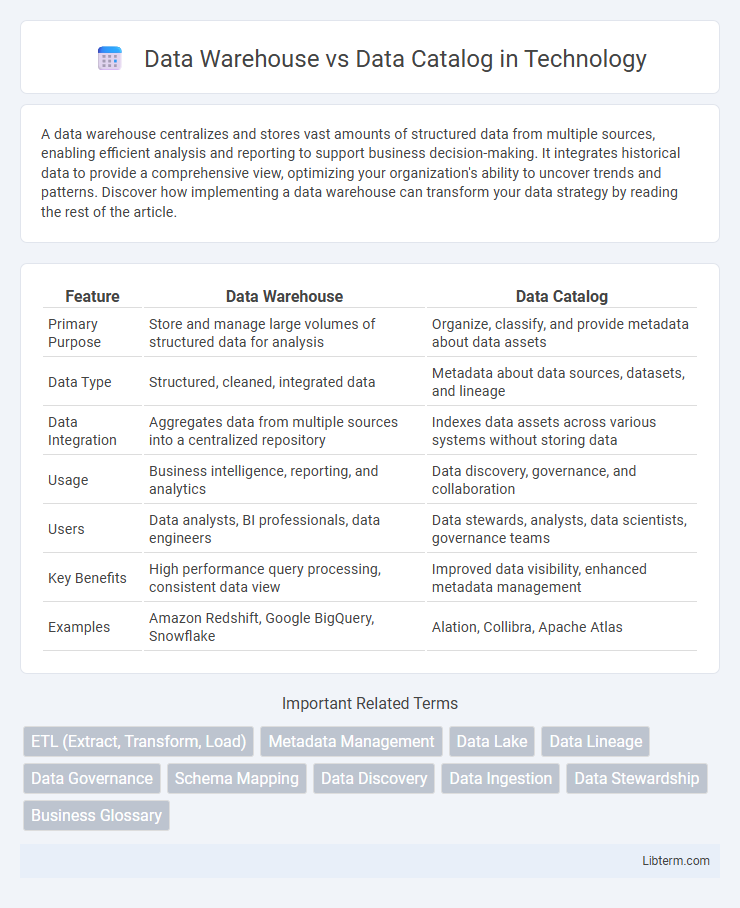A data warehouse centralizes and stores vast amounts of structured data from multiple sources, enabling efficient analysis and reporting to support business decision-making. It integrates historical data to provide a comprehensive view, optimizing your organization's ability to uncover trends and patterns. Discover how implementing a data warehouse can transform your data strategy by reading the rest of the article.
Table of Comparison
| Feature | Data Warehouse | Data Catalog |
|---|---|---|
| Primary Purpose | Store and manage large volumes of structured data for analysis | Organize, classify, and provide metadata about data assets |
| Data Type | Structured, cleaned, integrated data | Metadata about data sources, datasets, and lineage |
| Data Integration | Aggregates data from multiple sources into a centralized repository | Indexes data assets across various systems without storing data |
| Usage | Business intelligence, reporting, and analytics | Data discovery, governance, and collaboration |
| Users | Data analysts, BI professionals, data engineers | Data stewards, analysts, data scientists, governance teams |
| Key Benefits | High performance query processing, consistent data view | Improved data visibility, enhanced metadata management |
| Examples | Amazon Redshift, Google BigQuery, Snowflake | Alation, Collibra, Apache Atlas |
Introduction to Data Warehouse and Data Catalog
A Data Warehouse is a centralized repository designed to store large volumes of structured data from multiple sources for analysis and reporting, enabling business intelligence and decision-making processes. A Data Catalog serves as a metadata management tool that provides an organized inventory of data assets, enhancing data discoverability, governance, and collaboration across an organization. Both technologies complement each other by ensuring data is systematically stored, easily located, and effectively utilized for seamless analytics workflows.
Core Functions and Objectives
Data warehouses centralize and store large volumes of structured data to enable efficient querying, reporting, and analytics for informed business decisions. Data catalogs provide a metadata management system that organizes, indexes, and documents data assets, enabling data discovery, governance, and collaboration across an organization. While data warehouses focus on consolidating and optimizing data storage, data catalogs prioritize data accessibility, classification, and trustworthiness.
Architecture Overview
Data Warehouse architecture centralizes massive volumes of structured data from multiple sources into a unified repository optimized for query and analysis, typically using ETL processes, schema design like star or snowflake, and OLAP engines. Data Catalog architecture focuses on metadata management, providing a searchable inventory of data assets with automated data discovery, metadata extraction, lineage tracking, and governance capabilities integrated across diverse data environments. While Data Warehouses structure and store data for business intelligence, Data Catalogs enhance data accessibility and governance by organizing metadata and enabling efficient data asset management.
Key Differences Explained
Data warehouses centralize large volumes of structured data for analysis and reporting, enabling complex queries and BI applications. Data catalogs serve as metadata management tools, providing searchable documentation and classification of data assets across an organization. Unlike data warehouses, data catalogs enhance data discovery, governance, and collaboration by indexing both structured and unstructured data sources.
Use Cases for Data Warehouses
Data warehouses primarily serve as centralized repositories that consolidate and store large volumes of structured data from multiple sources, optimized for complex queries and analytics, supporting business intelligence, reporting, and historical data analysis. They enable organizations to perform trend analysis, financial forecasting, and customer behavior mining by providing fast query performance and data consistency. Unlike data catalogs that focus on data discovery and metadata management, data warehouses are designed for efficient data integration and high-speed querying to drive decision-making processes.
Use Cases for Data Catalogs
Data catalogs enhance data governance by providing a centralized inventory that makes data assets easily discoverable, understandable, and accessible across an organization. They are especially useful for data analysts and scientists to quickly locate relevant datasets, understand data lineage, and ensure compliance with regulatory requirements. In contrast to data warehouses that store large volumes of structured data for analysis, data catalogs focus on metadata management to improve data usability and collaboration.
Integration and Interoperability
Data warehouses consolidate structured data from multiple sources into a centralized repository optimized for query performance, enabling seamless integration through extract, transform, load (ETL) processes and standardized schemas. Data catalogs enhance interoperability by providing metadata management, data lineage, and universal data discovery across diverse data environments, facilitating unified access and governance. Effective integration combines data warehouse efficiency with data catalog metadata intelligence, ensuring comprehensive data visibility and consistent usage across platforms.
Benefits and Challenges
Data warehouses provide centralized storage and fast querying of large volumes of structured data, enabling comprehensive analytics and reporting, but face challenges in scalability and integration with diverse data sources. Data catalogs offer enhanced data discovery, governance, and metadata management, improving data accessibility and collaboration, yet require continuous maintenance and accurate metadata to remain effective. Both tools complement each other by balancing efficient data storage with comprehensive data knowledge management to support informed decision-making.
Choosing the Right Solution
Choosing the right solution between a data warehouse and a data catalog depends on the organization's data management goals. A data warehouse centralizes and stores large volumes of structured data for fast querying and analytics, supporting business intelligence and reporting needs. In contrast, a data catalog provides metadata management and data discovery, enabling users to efficiently locate, understand, and govern data assets across various sources.
Future Trends in Data Management
Data warehouses will increasingly integrate with advanced analytics and machine learning to support real-time decision-making and predictive insights, enhancing enterprise data utilization. Data catalogs will evolve by incorporating AI-driven metadata management and automated data lineage tracking, improving data discovery, governance, and compliance across complex data ecosystems. The convergence of these technologies will facilitate seamless data democratization and foster a more agile, data-driven organizational culture.
Data Warehouse Infographic

 libterm.com
libterm.com